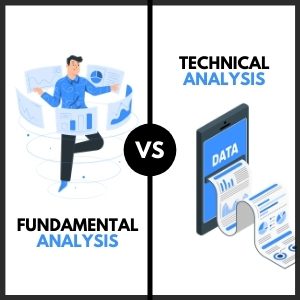Description : Understand the basic difference between fundamental and technical analysis of stocks to determine the quality of long-term investments
Fundamental Analysis
Fundamental analysis is done to identify the intrinsic value of an asset/ security. A fundamental analysis involves understanding the factors impacting company’s equity valuation from multiple lenses (macro as well as micro). The purpose of fundamental analysis is to estimate the value of the security and then compare it with the current market price to decide whether the security is under or over-valued; and does it make sense to invest in the security at current price for long term.
Fundamental analysis/ investment is about long term investing and value creation.
A Fundamental analyst looks as multiple factors in detail before making an investment decision in a company.
A few of them are as under.
Financial performance :- Analyzing historical financial performance of a Company is important to understand the business and how the Company has performed on Growth, Margins, Return on invested Capital during the selected time frame. A fundamental analyst usually looks at the historical financial performance of the Company and peers ranging from 5 -10 years and drivers behind the under/out performance.
Apart from performance, it is also important to understand the balance sheet strength by looking at liquidity, leverage, coverage ratios, credit rating during the analysis period.
Management/ Strategy :- Understanding the management and the Corporate vision and strategy is equally important. A Fundamental analyst looks at the management history, education and also tracks the announcements made and how they have delivered on promises made to the investors to form a perspective around management credibility.
A fundamental analyst also looks at the Company’s strategy/ vision to understand the priorities of the business. Whether it is increasing growth through introduction of new products or geographies or increasing sales of existing products, cost reduction to improve returns/ margins, increasing customer satisfaction by providing Omni-channel experience, reducing leverage etc.
Industry/ Economic scenario :- Understanding the industry and Macro Economy scenario, consumer preference helps determine the market momentum behind the stock price performance.
For example, the current environment is of low economic growth due to the Covid 19 pandemic. Global growth is projected to remain flat to negative for next one year. Industries like automobile, Metals, Oil and Gas would be negatively impacted due to low demand, while the Pharmaceutical and Healthcare industry is positively impacted due to rising demand for medicines.
Before crisis, the Pharma industry in India under performed the broader markets due to several industry related headwinds (pricing pressure, regulatory issues etc.).
The insurance industry in India is currently under penetrated and may see a surge in demand due to the Covid 19 crisis.
Government policies, regulations (like providing relaxation to select sectors) also impact the stock price performance. Therefore, it is important to keep oneself up to speed on both the industry and economic scenario.
Implied Expectations :- Value of stock is driven by Growth, Returns and Investor Expectations.Understanding expectations around future performance that are embedded in the current stock price is important. This will help the analyst determine how the stock’s value would change with change in future performance.
In short, Fundamental analysis focuses on understanding “WHY” the Stock Price is “WHAT” it is.
Technical Analysis
Technical analysis involves forecasting the future price movements of a stock based on an understanding of past price movements. The Technical Analyst looks at the short term, long term stock price charts, and indicators (like Bollinger bands, Relative Strength Indicators etc.) to predict the future price movements.
Technical analysis applies more to short term investing and taking advantage of stock price movements.
It focuses on “WHAT” the stock price will be rather than “WHY”
Technical analysis is based on 3 assumptions
(i) Current asset/ security Price discounts all material information which is known to the market.
(ii) Stock Price moves in trends. Once a price trend is established, the future price direction is more likely to be in that direction. A Technical analyst buys stocks when prices are low and investor “FEAR is at PEEK” and sells stocks when stock prices are high and “GREED is at PEEK”.
(iii) History tends to repeat itself. In Technical analysis, the charts and patterns found in the past often gets repeated. Technical analysts use different indicators (Resistance, support etc.) to identify the patterns in the stocks.
Do you want to learn Value Investing from an Expert in Valuation Analyst skills?
Then sign up for The Valuation Analyst Skills Training (VAST) course at SKILLFIN LEARNING.
You will learn how to assess the business model of a company, analyze Annual Reports, create proforma standardized financial statements and business valuation methods, forecast future financial statements, extrapolate financial ratios and much more.
This course can help you in your quest to get a job as a financial analyst. It is also targeted at working professionals who want to learn value investing to make more money in the stock markets.
Good luck, keep learning!!



One thought on “Fundamental Analysis vs. Technical Analysis: Understanding the Differences”
Very informative article post.Really looking forward to read more. Cool.